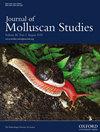雌雄同体淡水蜗牛 Planorbella trivolvis 的交配角色、交配持续时间和生殖产量
IF 1.2
4区 生物学
Q2 MARINE & FRESHWATER BIOLOGY
引用次数: 0
摘要
雌雄同体动物表现出多种多样的生殖策略,但实证研究却落后于有关其进化的理论。Planorbella trivolvis是一种雌雄同体动物,能够相互交配,也有罕见的自受精现象,为研究繁殖提供了一个独特的模式系统。这项研究评估了交配过程中的性别角色,证明交配主要是相互的,并研究了单次交配事件中的物理耦合与生殖产出之间的关系。蜗牛在性成熟前被分离出来,并以大小相匹配的组别放置在 10 升的水族箱中。交配后,成对的蜗牛被移到小杯中,直到它们分开;然后将它们隔离并计数卵,直到产卵停止。相互交配(交配后一对成员均产生卵块)的频率为 95%(35/37 次高产交配),高于之前的报道。产卵持续时间从 19 天到 197 天不等(平均值 ± SE = 110.13 ± 6.3 天),在交配后 15 到 20 周之间,卵块和每块卵块的产量急剧下降,这与之前对精子储存的估计一致。交配持续时间与总产卵量(精子可用性的生物标志)或产卵持续时间(精子寿命的标志)之间没有关系。需要进一步调查,以直接估算精子转移,并将相互身体接触的持续时间与配子和附属蛋白转移的持续时间区分开来。本文章由计算机程序翻译,如有差异,请以英文原文为准。
Mating roles, copulation duration and reproductive output in the hermaphroditic freshwater snail Planorbella trivolvis
Hermaphrodites exhibit a wide variety of reproductive strategies, yet empirical studies lag behind theories about their evolution. Planorbella trivolvis, a simultaneous hermaphrodite capable of reciprocal copulation and rare self-fertilization, provides a unique model system for studying reproduction. This study assessed sex roles during mating, demonstrating that mating is primarily reciprocal, and investigated the relationship between physical coupling and reproductive output for single copulation events. Snails were isolated before sexual maturity and placed in 10-l aquaria in size-matched groups. Upon copulation, pairs were removed to small cups until they separated; they were then kept isolated and eggs counted until egg production ceased. The frequency of reciprocal copulation (both members of a pair produced egg masses following copulation) was 95% (35/37 productive matings), higher than previously reported. The duration of egg production ranged from 19 to 197 days (mean ± SE = 110.13 ± 6.3 days) with a sharp drop in production of egg masses and eggs per mass occurring between 15 and 20 weeks postmating, consistent with previous estimates of sperm storage. There was no relationship between mating duration and total egg production (a biomarker of sperm availability) or the duration of egg production (a marker of sperm longevity). Further investigation is needed to directly estimate sperm transfer and tease apart the duration of reciprocal physical contact from gamete and accessory protein transfer.
求助全文
通过发布文献求助,成功后即可免费获取论文全文。
去求助
来源期刊

Journal of Molluscan Studies
生物-动物学
CiteScore
3.00
自引率
8.30%
发文量
36
审稿时长
3 months
期刊介绍:
The Journal of Molluscan Studies accepts papers on all aspects of the study of molluscs. These include systematics, molecular genetics, palaeontology, ecology, evolution, and physiology. Where the topic is in a specialized field (e.g. parasitology, neurobiology, biochemistry, molecular biology), submissions will still be accepted as long as the mollusc is the principal focus of the study, and not incidental or simply a convenient experimental animal. Papers with a focus on fisheries biology, aquaculture, and control of molluscan pests will be accepted only if they include significant advances in molluscan biology. While systematic papers are encouraged, descriptions of single new taxa will only be considered if they include some ‘added value’, for example in the form of new information on anatomy or distribution, or if they are presented in the context of a systematic revision or phylogenetic analysis of the group.
 求助内容:
求助内容: 应助结果提醒方式:
应助结果提醒方式:


